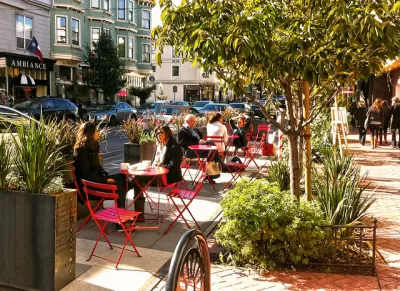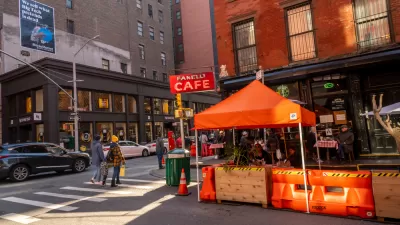The social and economic upheaval of the last two years accelerated a shift in thinking about how we use public space and organize the urban realm.

After decades of glacial progress on shifting public space away from a focus on cars, the disruption brought on by COVID-19 led to a radical rethinking of how we use roads and sidewalks. As Adam Rogers writes,
The virus—and specifically the understanding that as an aerosol it spread more easily in poorly ventilated spaces—changed something fundamental about urban life. The expansion of restaurants to curbside spaces and the closure of city streets to automobiles began in 2020, but in 2021 those alterations felt like a new phase in a decades-old cold war over the look and feel of the modern city.
Although the pandemic also halted progress that cities were making on increasing density and boosting public transit use, Rogers writes, the focus on social distancing and access to the outdoors brought a new urgency to reinventing the right-of-way for more people-oriented uses and encouraging walkable, bikeable neighborhoods. But this hasn't come without its own challenges: as cities scramble to create new regulatory frameworks for pandemic-era projects, the process often becomes onerous and expensive for small businesses and organizations. Meanwhile, disability advocates caution that some parklets impede access for wheelchairs, and public space proponents criticize dining setups for using public right-of-way for private businesses.
Nevertheless, Rogers concludes optimistically, "this new image of the city offers a sense of possibility—of hope, even—in the fight against climate change and inequality."
FULL STORY: The Pandemic Might Have Redesigned Cities Forever

Alabama: Trump Terminates Settlements for Black Communities Harmed By Raw Sewage
Trump deemed the landmark civil rights agreement “illegal DEI and environmental justice policy.”

Study: Maui’s Plan to Convert Vacation Rentals to Long-Term Housing Could Cause Nearly $1 Billion Economic Loss
The plan would reduce visitor accommodation by 25% resulting in 1,900 jobs lost.

Planetizen Federal Action Tracker
A weekly monitor of how Trump’s orders and actions are impacting planners and planning in America.

Baltimore Ordered to Improve Sidewalk Accessibility
The city is one of many to face lawsuits for failing to comply with the Americans with Disabilities Act.

This Toronto Suburb Has More Bus Riders Than Columbus, Ohio
Brampton, Ontario used gradual improvements in service to prove that if you build it, they will ride.

Paris Bike Boom Leads to Steep Drop in Air Pollution
The French city’s air quality has improved dramatically in the past 20 years, coinciding with a growth in cycling.
Urban Design for Planners 1: Software Tools
This six-course series explores essential urban design concepts using open source software and equips planners with the tools they need to participate fully in the urban design process.
Planning for Universal Design
Learn the tools for implementing Universal Design in planning regulations.
Smith Gee Studio
Alamo Area Metropolitan Planning Organization
City of Santa Clarita
Institute for Housing and Urban Development Studies (IHS)
City of Grandview
Harvard GSD Executive Education
Toledo-Lucas County Plan Commissions
Salt Lake City
NYU Wagner Graduate School of Public Service




























